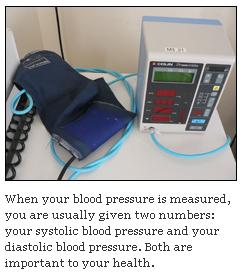Blood Pressure 101

by jessica swienckowski and mark yarchoan
High blood pressure (also known as hypertension) is a major health risk, especially for people with diabetes. It is estimated to affect one in three adult Americans and, strikingly, two out of three people with diabetes. Despite its frequency, high blood pressure is often poorly understood by patients. What makes hypertension especially dangerous is that it is often without symptoms even though it is causing damage to the body. For this reason, it is sometimes referred to as a “silent killer.”
So what is high blood pressure, anyway? Simply put, blood pressure is the force of blood flow inside of blood vessels. Multiple factors regulate blood pressure, and as a result there are many different reasons that blood pressure may be elevated. Several factors that are known to raise blood pressure are discussed below.
The bottom line is that high blood pressure means that your heart has to work harder to push blood around. This is why high blood pressure causes cardiac problems, such as heart attacks and heart failure. The increased force of blood can also damage blood vessels, causing the accumulation of cholesterol “plaques,” and increasing the risk of strokes and aneurysms. Since patients with diabetes may be at a higher risk for heart disease and stroke independent of hypertension, it is critically important for people with diabetes to maintain good control of their blood pressure. In addition, high blood pressure can contribute to the progression of diabetic complications, including retinopathy (damage to the blood vessels in the eyes) and nephropathy (damage to the blood vessels in the kidneys). In addition, high blood pressure can contribute to several diabetic complications, including retinopathy (damage to the blood vessels in the eyes) and nephropathy (damage to the blood vessels in the kidneys).
High blood pressure may be diagnosed during a routine doctor visit. However, if you are concerned about your risk for developing high blood pressure, you may consider purchasing a home blood pressure monitoring device. They are now small, easy to use, and range in price from $20 (for manual arm cuffs) to $60-80 (for automated cuffs).
For good reason, blood pressure is the “B” of the diabetes ABCs, and we describe below what your numbers mean, the causes of hypertension and its effects on your body, and the basics of how hypertension is prevented and treated.
 blood pressure: the basics
blood pressure: the basics
When you get your blood pressure taken, you are usually given two numbers: your systolic blood pressure and your diastolic blood pressure. Systolic blood pressure measures the peak pressure in arteries that occurs when the heart’s ventricles (lower chambers) are contracting. Diastolic blood pressure measures the minimum pressure in the arteries that occurs when the heart’s ventricles are relaxed. Blood pressure is measured in millimeters of mercury (mmHg), and systolic blood pressure is usually reported “over” diastolic blood pressure (i.e., 120/80, or “120 over 80”).
Children typically have lower blood pressure than adults, and blood pressure tends to slowly rise with age, with the gap between systolic and diastolic pressure sometimes widening. Men tend to be at higher risk than women until age 45, after which the sexes remain at equal risk until the risk for women becomes much higher above age 65.
While blood pressure values will vary from individual to individual and even fluctuate throughout the day for any given person, the National Heart, Lung, and Blood Institute at the National Institutes of Health (NIH) has set some guidelines to help diagnose consistent abnormal blood pressure.
Below are the most recent guidelines from the NIH website for healthy adults:
| Category | Systolic BP (mmHg) – Top number! | Diastolic BP (mmHg) – Bottom number! | |
| Normal | below 120 | AND | below 80 |
| Prehypertension | 120-139 | OR | 80-89 |
| High Blood Pressure Stage 1 | 140-159 | OR | 90-99 |
| Stage 2 | above 160 | OR | above 100 |
* If systolic and diastolic blood pressures are not in the same category, the higher number (or more severe category) determines the diagnosis.
While these guidelines apply to most adults who do not suffer from chronic or short-term serious illnesses, it is recommended that patients with diabetes keep their blood pressure below 130/80 mmHg.
getting a grip on blood pressure
While blood pressure levels are in part determined by genetics, lifestyle also strongly affects blood pressure. In particular, high salt consumption leads to high blood pressure over the long run. While many people with diabetes have become accustomed to looking up the fat and sugar content of foods, salt is too often overlooked and is also extremely important. Sedentary lifestyle, excessive alcohol consumption, and smoking can also raise blood pressure over time. You can take an active role in modifying several of these factors to reduce your risk. If there is a family history of high blood pressure, you should be particularly vigilant about monitoring and managing your blood pressure.
The following table highlights risk factors for high blood pressure:
| Modifiable Risk Factors | Unmodifiable Risk Factors |
| Diet | Genetics/Family History |
| Exercise | |
| Alcohol Consumption | |
| Tobacco Use | |
| Weight Gain |
You can do many things to keep your blood pressure down, some of which overlap with health and lifestyle recommendations for managing diabetes (please see www.diabetes.org for additional resources and information on how to manage blood pressure):
-
Prevent Weight Gain and/or Lose Weight – Cutting back on unnecessary calories, especially fat calories, and maintaining good fitness can help you stay at a healthy weight.
-
Exercise – While it is best for you to consult with your physician about an exercise routine appropriate for you, a good rule of thumb is to try to do at least 30 minutes of brisk activity most days of the week. Many people complain that they don't have time for exercise, but even implementing little changes in behavior such as walking up stairs rather than taking the elevator can add up.
-
Eat Well – The American Diabetes Association (ADA) recommends a serving of fruit at each meal, one to two servings of vegetables at lunch and dinner, low-fat and fat-free dairy products, whole grains and cereals, nuts or peanut butter (occasionally), lean meats and meat-substitutes, low fat cooking methods (grilling, roasting, baking), and low salt consumption.
-
Make Smart Choices About Alcohol – If your physician believes it is safe for you to drink alcohol, women should limit consumption to one drink per day while men should limit consumption to two drinks per day. While some experts believe that a small amount of alcohol every day has positive health effects, larger amounts of alcohol raises blood pressure and has other problematic effects on health.
-
Quit Smoking – In case you need another reason to kick your habit, nicotine can increase blood pressure by 5 to10 mm Hg. Also, smoking can directly increase the risk of heart disease and stroke, and so the combination of smoking and high blood pressure is particularly dangerous.
blood pressure medications
You may find that these lifestyle changes are not enough to help you get your blood pressure under adequate control, in which case you will need to talk to your physician about potentially adding medication to your therapy regimen. There are several blood pressure lowering medications available to help patients control high blood pressure. We detail a few below to help you start the conversation with your physician:
The following table details management strategies for controlling high blood pressure:
-
ACE inhibitors – These medications prevent the body from making a hormone called angiotensin II, which causes blood vessels to constrict. Therefore, ACE inhibitors makes blood vessels more relaxed, lowering blood pressure. Most ACE inhibitors are generic (the original patent has expired), making them very cheap. This class of drug is considered to be safe but one side effect some people experience is a chronic cough. People who develop a cough while taking an ACE inhibitor may consider switching to an ARB (see below). ACE inhibitors are also not recommended for women who are pregnant or are planning pregnancy. Examples of ACE inhibitors include lisinopril, ramipril, and enalapril.
-
ARBs (Angiotensin Receptor Blockers) – Similar to ACE inhibitors, this class of drug makes vessels more relaxed by blocking angiotensin II. ARBs have become very popular because they may have fewer side effects than ACE inhibitors. Both classes of drugs are thought to be similarly effective and safe. Examples of ARBs include Diovan, Cozaar, and Atacand (Cozaar may go generic in 2010, reducing its price).
-
Beta Blockers – This class of medication makes the heart to beat slower and with less force and is also prescribed for other reasons, including heart attack prevention and to treat debilitating nervous reactions to stress. It should be noted that many beta blockers may interfere with the body's response to hypoglycemia, making it harder to recognize low blood sugar levels. Examples of beta blockers include Sectral, Tenormin, and Zebeta.
-
Calcium Channel Blockers – This class of medication works directly on the blood vessels to keep them relaxed, lowering blood pressure. Examples include Norvasc, Plendil, and Sular.
-
Diuretics – These medications are designed to help you lower the fluid volume of your blood (which can also contribute to high blood pressure) by encouraging your body to eliminate excess water and sodium through the urine. Examples include Diuril and Dyrenium.
The following table details management strategies for controlling high blood pressure:
| Lifestyle Modifications | Medications | |
| Healthy Diet | If lifestyle modifications listed on the left are followed and patient is unable to achieve blood pressure control, medications on the right may be prescribed. | ACE Inhibitors |
| Regular Exercise | ARBs | |
| Weight Loss | Beta Blockers | |
| Reduced Alcohol Use | Calcium Channel Blockers | |
| Smoking Cessation | Diuretics |

.JPG)






